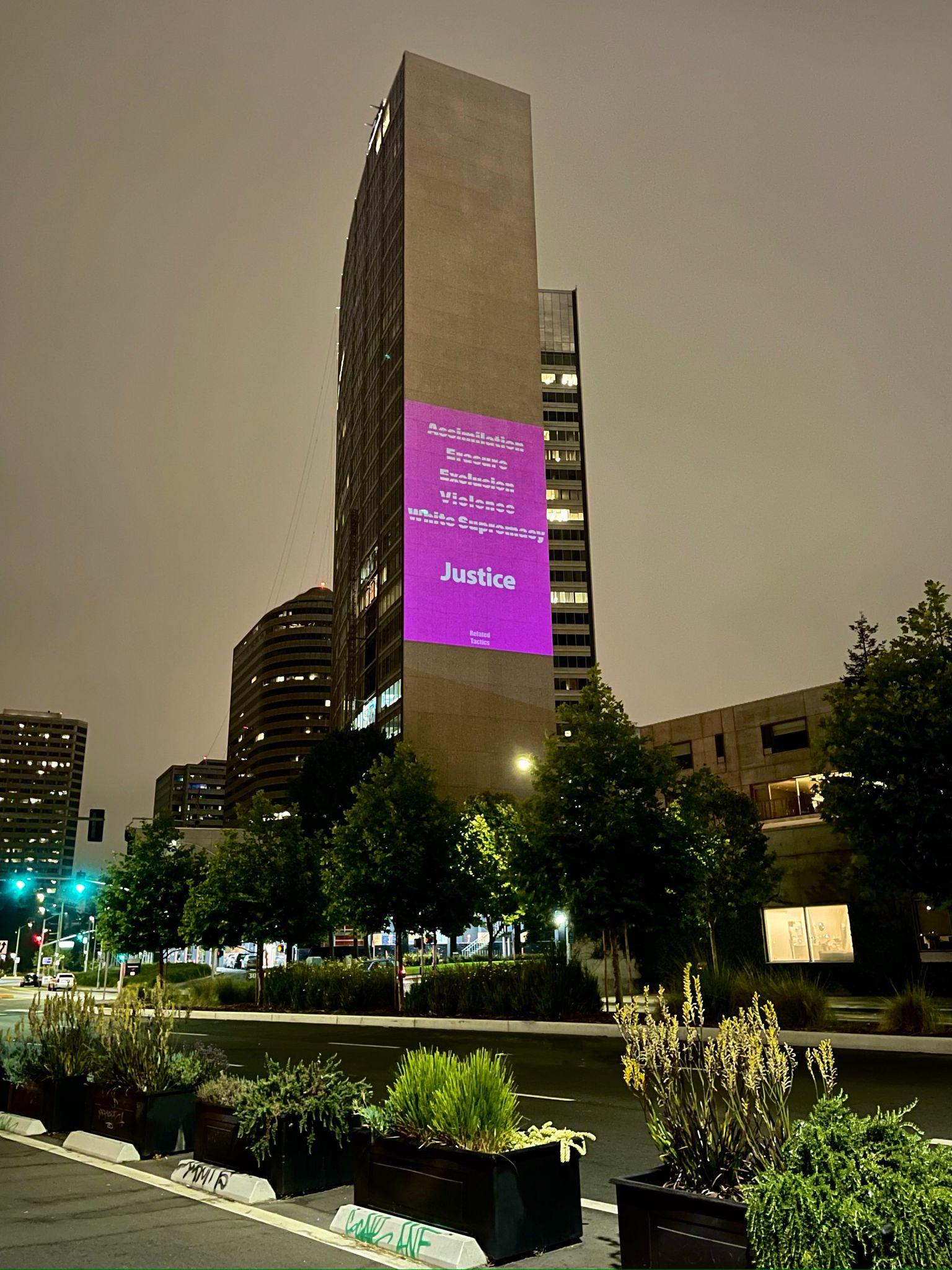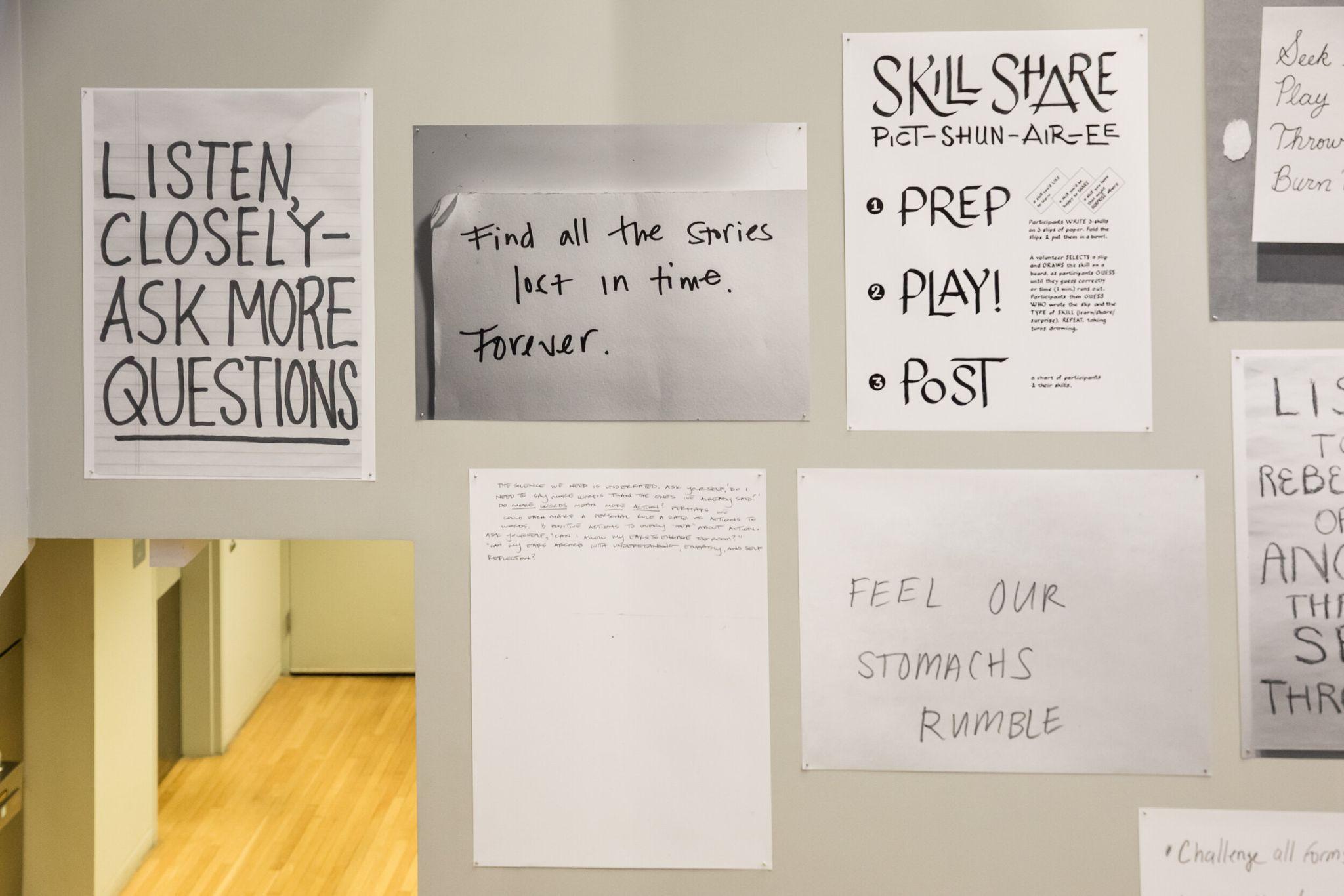Related Tactics—a Bay-Area Collective—Announced as 2023 Rainin Fellow and Awarded $100K


Today, The Rainin Foundation announced its 2023 fellows among them are the creative collective Related Tactics within the category ‘Public Space.’ They will receive an unrestricted $100,000, plus tailored supplemental support, designed to amplify the impact of the grant, both for the artists and the community. Launched in March 2021, the Fellowship funds Bay Area artists ”who push the boundaries of creative expression, anchor local communities, and advance the field.”
To break down institutional boundaries and present more diverse perspectives within the art and craft spheres Michele Carlson, Weston Teruya, and Nathan Watson founded the collective Related Tactics in 2015. They present projects that combine curatorial strategies of presentation and artistic gestures to share knowledge and art on topics of racial and cultural legacies, injustices, and their power structures.


In a window display at The Luminary, St Louis in 2021 they presented “Who Else But Americans…” which in its final form comprised some 6,000 images—each image representing a life lost. It is based on the groups research on the United States first transcontinental railroad centering on the human lives sacrificed to build it. Based on the estimated three lives lost for every two miles of track laid they followed the track stopping every two miles to capture three photographs or screengrabs starting in California and moved East following the track through site visits, Google Maps, and various archives. Their collaborative project “Ready” presented at Berkeley Arts Center in 2019 and at the Wexner Center for the Arts in 2021 as a part of “Climate Changing: On Artists, Institutions, and the Social Environment” invited other artist to join them in “making and deploying a collection of creative interventions, tools, and strategies that can be used to interrupt systems of marginalization, exploitation, and erasure, large and small.” The participating artist shared their thoughts in text-based works describing actions and interventions displayed at the museum and a free handout was also distributed ushering audiences to continue to develop these ideas within their own frameworks and contexts beyond the museum.
Together, the collective has created over ten solo projects since its inception and exhibited in more than nine group shows.
Beyond the collective and their individual artistic practices, Carson is an associate professor of printmaking at George Washington University and from 2011-2016 she worked with Hyphen, a media outlet for Asian American culture and politics. Weston Teruya has a long career in grant. making and arts fund development and host of the podcast “(un)making,” Nathan Watson is the Executive Director of Public Glass, a non-profit. Their experience within academia, publishing, arts leadership, and public policy make them apt to question but also find new solutions for the systems they work within.
Other 2023 fellows are Joanna Haigood (Dance), Sean San José (Theater), and Mohammad Gorjestani (Film). Against the backdrop of the Bay Area’s important cultural history, it makes sense that the Kenneth Rainin Foundation funds interdisciplinary projects focusing on its community and visionary ideas.
Since the 1960s, creatives of the Bay Area have instrumentalized art and forward-thinking cultural ideas based on civic responsibility to better their own lives and life for others. The Black Arts Movement has a stronghold in Berkeley and the surrounding areas—impacted by African Independence and American Civil Rights calls for Black Power influenced by Pan-Africanism, Malcolm X, and James Baldwin expression centred around political action and self-determination. Rejecting repressive and demeaning imagery, local artists embraced African culture and design motifs as they gathered to share art and information and organized exhibitions using creative expression to further community empowerment. Carol Ward Allen, Casper Banjo, James Lawrence and mixed media artist Marie Johnson of The Bay Area Black Artists (BABA) Collective exhibited their works around Oakland and the East Bay. While Emory Douglas, Black Panther Party Minister of Culture, and Tarika Lewis, or Matilaba, contributed art to the Black Panther newspaper, Angela Davis has credited Betye Saar’s work “The Liberation of Aunt Jemima” (1972) with igniting the black women’s movement.
These ideas of self-determination and lifestyle awareness extended into various counter-culture movements. People used DIY, craft, organic farming, communal and back-to-the-land living, architecture, music (Jefferson Airplane and the Grateful Dead originated in the Bay area), and art to find new ways to live and design their lives beyond the mainstream. The GI bill—subsidized education for veterans returning from the Vietnam War—buoyed the growth of art and crafts schools to expand their programs around the country. Several of the most experimental ones led by teachers and students from the Bauhaus—like Black Mountain College in Asheville, North Carolina. There was an overlap between the black arts and the civil rights movement, counter-culture, and the emergence of craft. But, white and black artists were often exhibited separately, as were art and craft.
In the current exhibition, “Disclosure: The Whiteness of Glass” at Center for Craft in Asheville, North Carolina Related Tactics have invited glass artists to respond to demographic data about their field detailing its lack of artists of color amongst tenured faculty in glass programs, directors and board chairs of craft institutions, and directors and board chairs of glass community organizations. This original dataset was produced for a 2020 essay in New Glass Review, published by Corning Museum of Glass. Their research showed that less than one percent of tenured faculty in four-year university and college glass programs are black, the same number for non-profit studio and community education program leadership, and zero percent of glass and craft museum directors or board chairs were black.
“To work towards cultural equity, institutional critique, and community-building,” the exhibition in Asheville, a center for craft, showcases three iterative stages of interpretation: originating data visualizations by Related Tactics; artist instruction responses by Joyce Scott, Ché Rhodes, Einar & Jamex de la Torre, Cheryl Derricotte, Corey Pemberton, and Emily Leach; and glass responses by Victoria Ahmadizadeh Melendez, Vanessa German, Helen Lee, Pearl Dick, Kim Thomas, and Raya Friday.

Related Tactics were awarded the fellowship for Public Space, naturally, they have created works within this category. Namely, they created two projection contributions to Christy Chan’s project “Dear America” which projected work by and in solidarity for AAPI artists in Oakland, San Jose, and at Montalvo Center for the Arts as Asian-American dissent increased in conjunction with the spread of COVID-19 in 2021. On the term ‘Public Space’ The Rainin Foundation comments: “Public Space projects are place-based public art experiences that engage community members on issues relevant to them. These site-specific works encompass a wide range of art forms and often create space for new dialogues and forms of connection to emerge.”
The Rainin Fellowship is administered by United States Artists who also administer programs for the Ford and Mellon Foundation. “The national arts funding nonprofit that supports the country’s most compelling artists and cultural practitioners,” The Rainin Foundation told Cultbytes. This year’s Rainin fellows were selected through a two-part review process with the help of national reviewers and a panel of four local jurors. The reviewers were Roya Amirsoleymani, Dominique Atwood, Casey Emile Baron, Zandashé Brown, Lisa Gonzales, Ka Oskar Ly, Nico Rodriguez Melo, Hana S. Sharif, Paz Tanjuaquio, Lauren Turner Hines, Rita M. Rufino Valente-Quinn, and Jennifer Wilson. The jurors were Rotimi Agbabiaka, Fay Darmawi, Lily Kharrazi, and PJ Gubatina Policarpio. There is a new group of reviewers each year.
The family-run organization has awarded more than $51 million to Bay Area-based arts organizations operating within dance, performing arts, visual arts, music, and film. For instance, with funds from the Rainin Foundation, SFFILM administers grants to support the creation of narrative feature films exploring social issues. In 2016, the foundation launched their “Open Spaces Program” funding public art with civic and community engagement components in Oakland and Francisco. Importantly, in a region where rents are increasing the foundation has various programs to aid arts organizations in meeting their needs in real estate.
You Might Also Like
Artists Discuss Sustainability and Eco-Activism at MOCA Los Angeles
Two Collectives are Using Instagram to Diversify the World of Film
Despite Tense Relations, A Pro-Ukrainian Video Art Platform Stages its 29th Program
What's Your Reaction?
Anna Mikaela Ekstrand is editor-in-chief and founder of Cultbytes. She mediates art through writing, curating, and lecturing. Her latest books are Assuming Asymmetries: Conversations on Curating Public Art Projects of the 1980s and 1990s and Curating Beyond the Mainstream. Send your inquiries, tips, and pitches to info@cultbytes.com.

